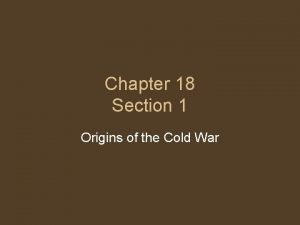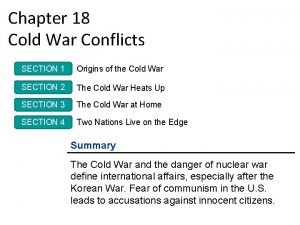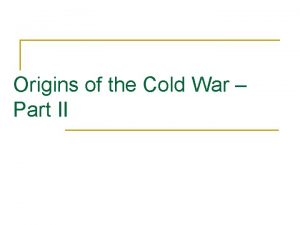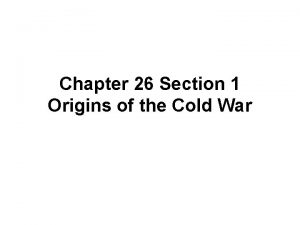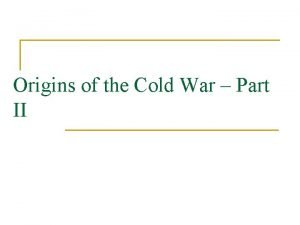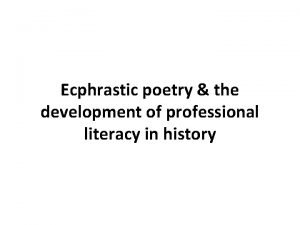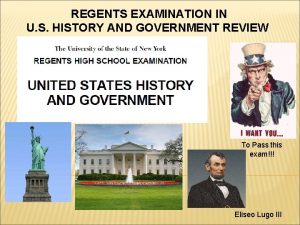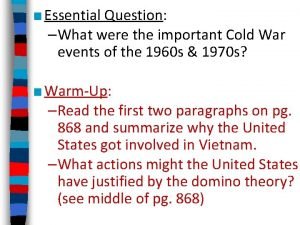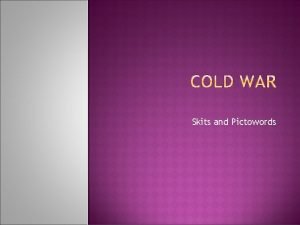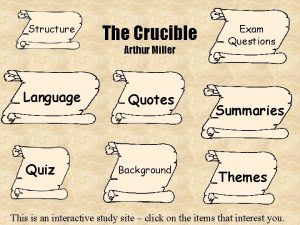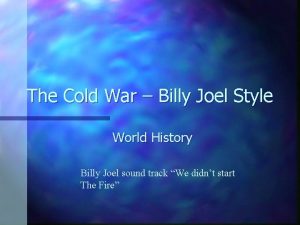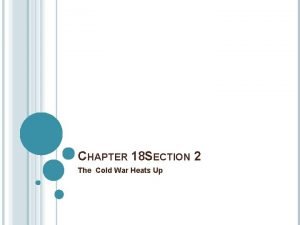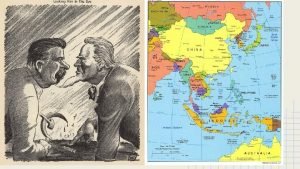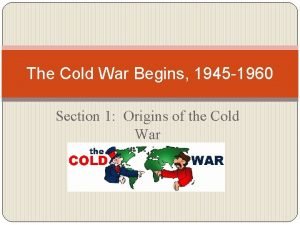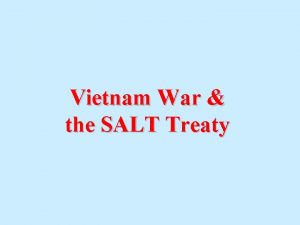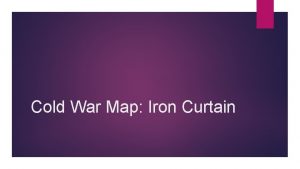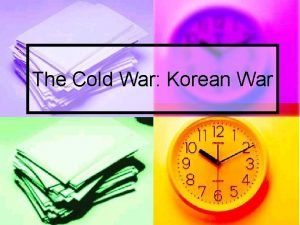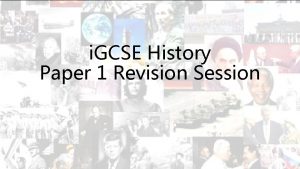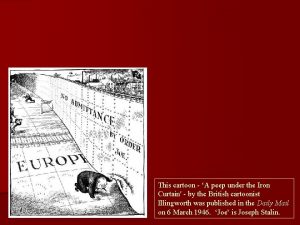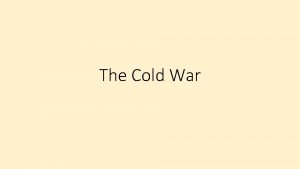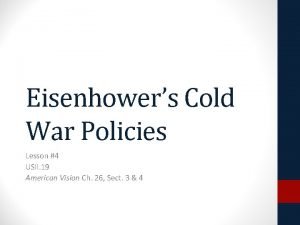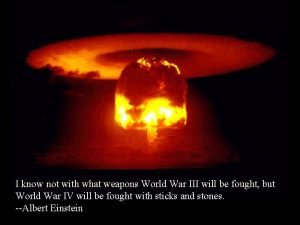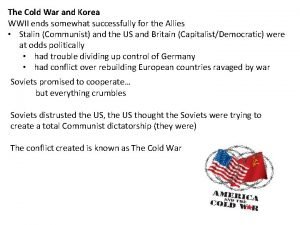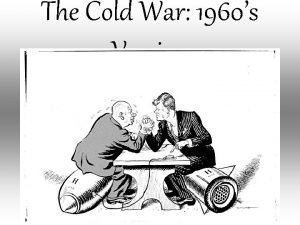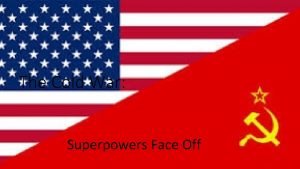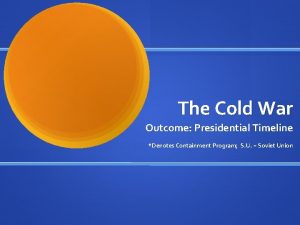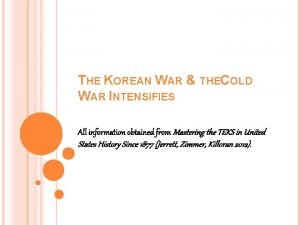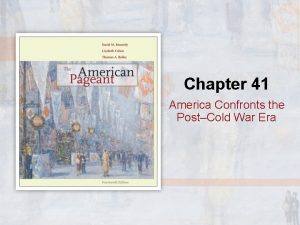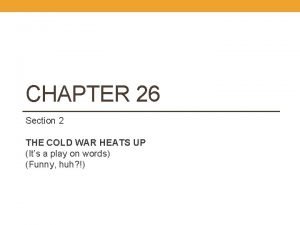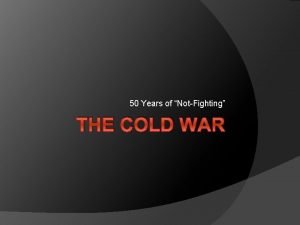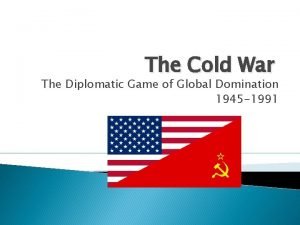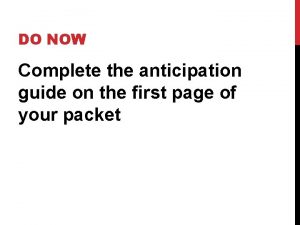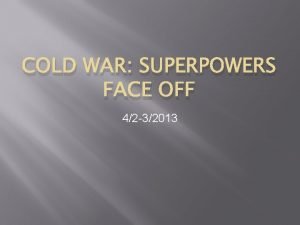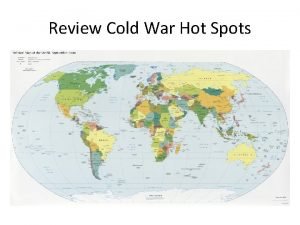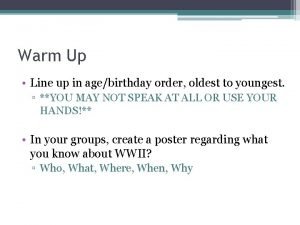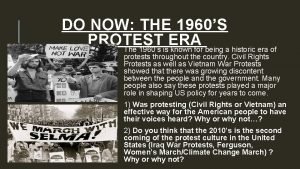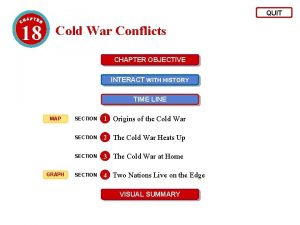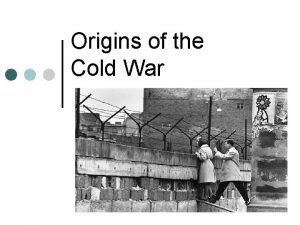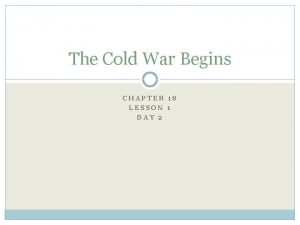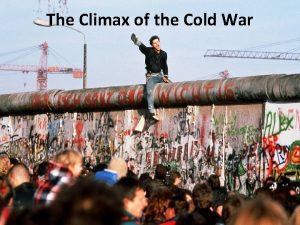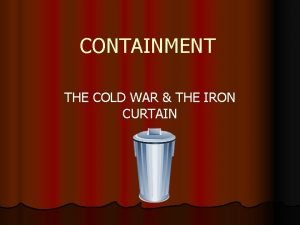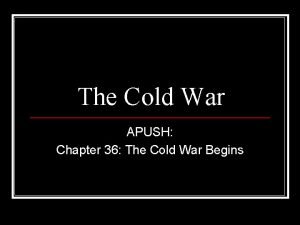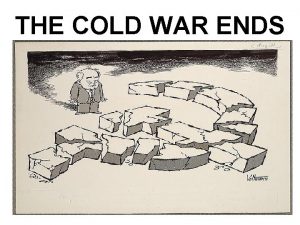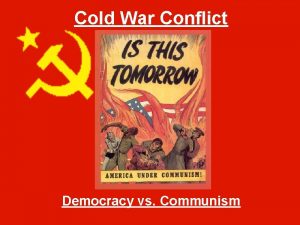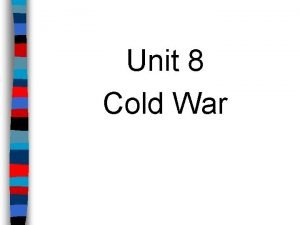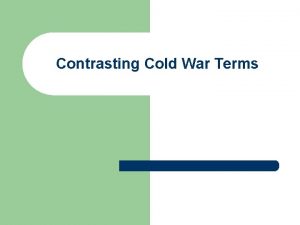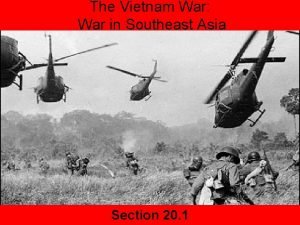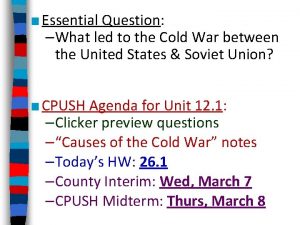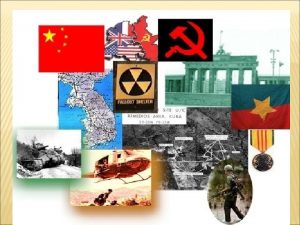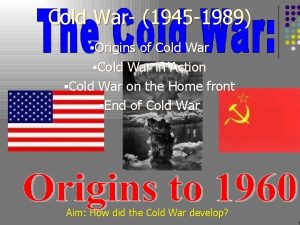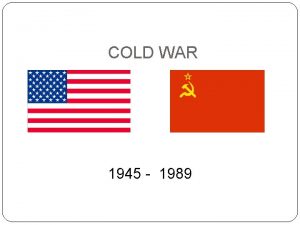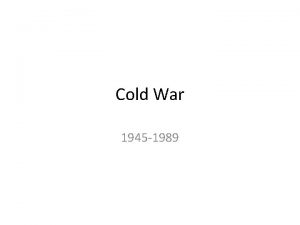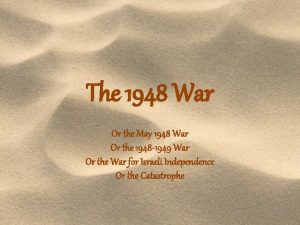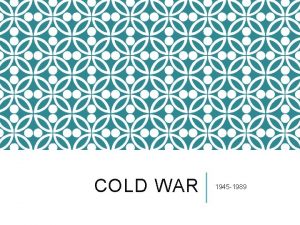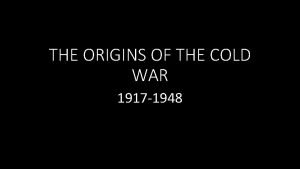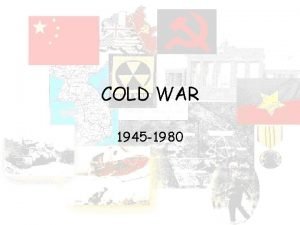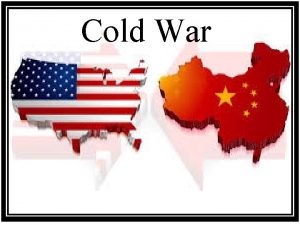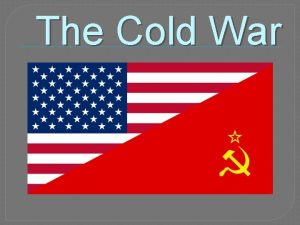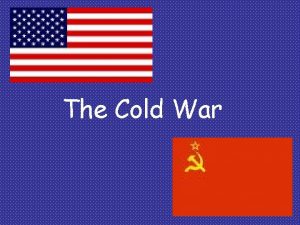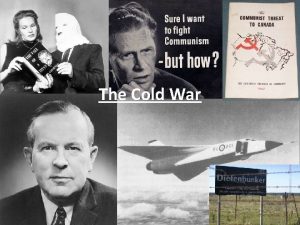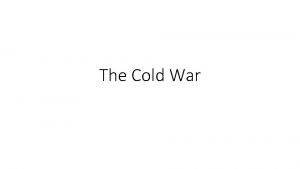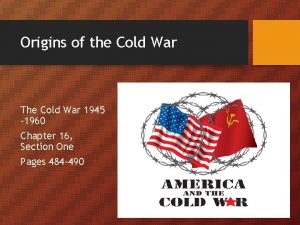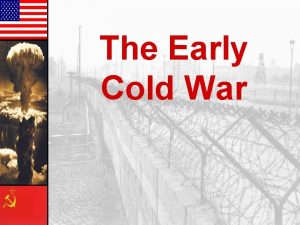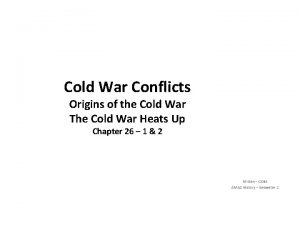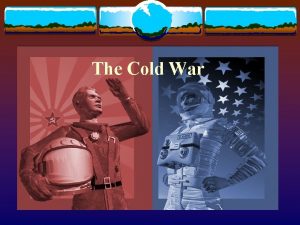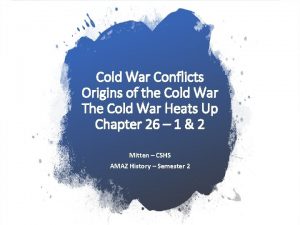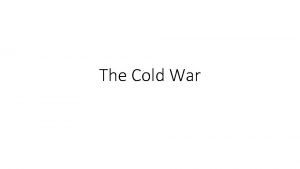THE COLD WAR 1948 1989 ORIGINS of the










![Marshall Plan [1948] The U. S. should provide aid to all European nations that Marshall Plan [1948] The U. S. should provide aid to all European nations that](https://slidetodoc.com/presentation_image_h2/78ee021c6b11b8e2e5b44ffba71f5362/image-11.jpg)













































- Slides: 56

THE COLD WAR (1948 -1989)

ORIGINS of the Cold War: (1945 -1948) • Tension or rivalry but NO FIGHTING between the United States and the Soviet Union • This rivalry divided the world into two teams (capitalism vs. communism)

1. The Yalta Conference- meeting in Yalta, U. S. S. R. Feb, 1945 Meeting of the “Big Three” (Stalin, Roosevelt, and Churchill) • Met to discuss the plan of post-war Europe • Decided to divide Germany into 2 countries • Roosevelt and Churchill agreed that Stalin had the right to control the governments of Eastern Europe after the war YALTA (in the USSR) Date: Feb 1945 Present: Churchill, Roosevelt and Stalin

2. Rivalry between the United States and the U. S. S. R “Communism and capitalism cannot exist in the same world”- Stalin United States VS. USSR -Encouraged democracy and capitalism -Encouraged dictatorship and communism -Worked to CONTAIN or stop the spread of communism - Worked to stop the U. S. influence in West Europe.

3. Communism vs. Capitalism • Capitalism - an economic system where business is privately owned and money is used to make more money • “Free Enterprise” – everyone is free to pursue any economic activity • Capitalism creates social classes – upper, middle and poor

3. Communism vs. Capitalism • Communism – an economic system where people share work fairly and paid equally • The goal is to get rid of social classes and make everything fair for everyone • The USSR was communist and ruled by a dictator • The government controlled all businesses

4. The “Iron Curtain” - Western Europe and the western half of Germany and Berlin was made up of democratic nations - Eastern Europe and the eastern half of Germany and Berlin was communist. - “Iron Curtain” divided them – also divided. Capitalism in Western Europe and a Communism in Eastern Europe

Europe Divided From Stettin in the Balkans, to Trieste in the Adriatic, an Iron Curtain has descended across the Continent. Behind that line lies the ancient capitals of Central and Eastern Europe. -- Sir Winston Churchill, 1946

5. President Truman and the Policy of Containment • President Truman did not like communism • Truman created a policy of “containment” – to stop the spread of communism. • Marshall Plan (created by George Marshall): provided aid (money) to countries in Europe to rebuild after WWII. • In order to receive money from the U. S, the country had to be a democracy. • The goal was to stop the spread of communism.

Policy of Containment “The U. S. should support free peoples throughout the world who were resisting takeovers by armed minorities or outside pressures…We must assist free peoples to work out their own destinies in their own way. ”
![Marshall Plan 1948 The U S should provide aid to all European nations that Marshall Plan [1948] The U. S. should provide aid to all European nations that](https://slidetodoc.com/presentation_image_h2/78ee021c6b11b8e2e5b44ffba71f5362/image-11.jpg)
Marshall Plan [1948] The U. S. should provide aid to all European nations that need it. Secretary of State, George Marshall $12. 5 billion of US aid to Western Europe. Money was extended to Eastern Europe & USSR, but was rejected.

Major CONFLICTS of the Cold War (1948 -1989)

1. NATO vs. Warsaw Pact

North Atlantic Treaty Organization (1949) Military alliance with US, Canada, and nine Western European countries These nations agreed to defend one another with armed force v United States v Belgium v Britain v Canada v Denmark v France v v v Luxemburg v Netherlands v Norway v Portugal v 1952: Greece & Turkey Iceland v 1955: West Germany Italy v 1983: Spain

Warsaw Pact (1955) USSR viewed NATO as a threat and created the Warsaw Pact Military alliance between USSR and seven Eastern Europe countries China (largest Communist country) distrusted USSR and remained unallied } U. S. S. R. } East Germany } Albania } Hungary } Bulgaria } Poland } Czechoslovakia } Rumania

2. Nuclear Weapons Theory of Deterrence } The Soviet Union exploded its first Abomb in 1949. } Now there were two countries with nuclear weapons!

2. Nuclear Weapons Theory of Deterrence • Cold War led to an “armed conflict” and fear of WWIII involving nuclear weapons • Theory of Deterrence: US was able and prepared to respond to any Soviet nuclear attack with an equally destructive strike An attack would result in the end of the world and because this was known, an attack never occurred. ***Deterrence is the OPPOSITE of appeasement

Theory of Deterrence

3. The Korean War: (1950 -1953) A Japanese colony divided into two Korean nations (38 th parallel): Non-Communist South Kim Il-Sung Communist North Syngman Rhee

The Korean War • North Korea invaded South Korea in 1950 in a surprise attack • President Truman committed U. S. forces to defend South Korea – Truman thought North Korean was repeating what the Axis powers tried to accomplish in the 1930’s

Korean Conflict Mac. Arthur led US forces against North Korea

Korean Conflict • Mao Zedong the leader of China sent troops in to fight Mac. Arthur and the USA Photo of Chinese troops entering Korea

Korean Conflict • In 1953, North and South Korea signed an armistice (cease fire) leaving Korea divided along the 38 th parallel • Korean War ended in a stalemate Approximately 5 million civilians and soldiers died in this war, even though the war ended the same way it started - divided

Korean War Memorial – Washington D. C.

Premier Nikita Khrushchev • Stalin dies in 1953 – Nikita Khrushchev emerges as the leader of the Soviet Union About the capitalist states, it doesn't depend on you whether we (Soviet Union) exist. If you don't like us, don't accept our invitations, and don't invite us to come to see you. Whether you like it or not, history is on our side. We will bury you. -- 1956 De-Stalinization Program was created Khrushchev denounced Stalin’s genocide

Post-War Germany

4. Berlin Wall (1961) To stop people from moving to West Berlin and from Communism - a wall was built on the border of East and West Berlin to separate the two. Called the Berlin Wall Berlin, Germany Divided into 4 zones

Ich bin ein Berliner! (1963) President Kennedy tells Berliners that the West is with them!

5. Cuban Missile Crisis (1962) • Fidel Castro became the dictator of Cuba in 1959 • Cuba is now a Communist nation US Intelligence discovered that the Soviet Union (led by Khrushchev) began building nuclear missile sites in Cuba

Khruschev Embraces Castro, 1961

Paris, 1961 Khrushchev & JFK meet to discuss Berlin and nuclear weapons. Khrushchev thinks that JFK is young, inexperienced, and can be rolled.

Cuban Missile Crisis (1962) Soviets want to tests Missiles Cuba is only 90 miles from the US President Kennedy demanded that the missiles be removed

Cuban Missile Crisis (1962) U. S. sets up a naval blockade to stop the Soviets from bringing more weapons into Cuba We went eyeball-to-eyeball with the Russians, and the other man blinked! The US also set up missiles in Turkey The blockade caused Khrushchev to remove the missiles

We went eyeball-to-eyeball with the Russians, and the other man blinked! What do you think this quote means? Answer in one to two sentences.

6. Vietnam War 1965 -1973 • During Imperialism, Vietnam became a French colony in the 1880’s • Vietnam became independent in 1945. • Communist leader Ho Chi Minh takes power in 1950

Vietnam Divided (1954) NORTH: Communist Supported by CHINA Led by Ho Chi Minh SOUTH: Non-Communist Supported by USA Led by Ngo Dinh Diem • Vietnam was partitioned (divided) in 1954 along the 17 th parallel

Vietnam (1954 – 1959) • 1954 – the country was divided (17 th parallel) and agreed to hold an election in 1956 to reunite the country. • 1956 - Diem cancels election in fear of losing. • Diem is eventually overthrown by a military coup (backed by the US) because of his corrupt and dictator like rule.

Vietnam (1954 – 1959) • North Vietnam leader Ho Chi Minh • North Vietnam military called Viet Cong • 1956 – Because the election fails Ho Chi Minh attempts to reunite the country with force (war). • 1959 – Viet Cong invades South.

Vietnam War: US Involvement • Containment not working in SE Asia. • Fear of communism created the “Domino Theory” – the belief that if one country became communist, others would fall like a row of dominos.

Vietnam War: US Involvement • The U. S. starts to send in troops to stop the spread of communism in South Vietnam and neighboring countries like Laos and Cambodia.

Vietnam War: Gulf of Tonkin • 1964 – 2 U. S. battleships stationed in the Gulf of Tonkin in Vietnam claimed they were fired upon by North Vietnamese forces.

Vietnam War: Gulf of Tonkin • In response, Congress passed the Gulf of Tonkin Resolution, allowing President Johnson to “take any measures he believed were necessary to retaliate and to promote the maintenance of international peace and security in Southeast Asia”. • This became the legal basis for the Vietnam War.



Obstacles for U. S. Success 1 – South Vietnamese are unmotivated to fight the North. • Many switch sides to support the North/Viet Cong. 2 - US is no match for the Viet Cong and Guerilla Warfare. • Home field advantage. They know the land well & use surprise attacks • Ho Chi Minh Trail 3 - US soldiers unsure why they are fighting • Soldiers were used as bait to draw out the Viet Cong. • Difficult to succeed - little land was gained for the US & quickly lost to Viet Cong. 4 - Vietnam had a purpose or motive to fight. • Vietnam was fighting for unification and their independence.

Tet Offensive • January 31, 1968 - 70, 000 North Viet Cong forces surprise attacked more than 100 cities and towns in South Vietnam. • North takes over South capital, Saigon. • Beginning of the end of war

Vietnamization President Nixon began a plan called “Vietnamization” – gradual pull out of US troops • 1973 – a cease fire was signed • 1975 - North Vietnam attacked South Vietnam and unifies the country. Today, Vietnam is a unified Communist country

Vietnam War: 1965 -1973 • In the United States, Americans were divided on whether our military should be involved in Vietnam

f o e s p a l l o C e h T n i m s i n u Comm n o i n U t e i v o S e h t ) 9 8 9 (1

1. Soviet Economic Collapse • War in Afghanistan – 10 year war that was expensive for USSR • 1980 s – poverty in USSR - people formed long lines to get food • 1986 – a nuclear disaster of Chernobyl in Ukraine furthered Soviet’s economic decline. • Hundreds died – most costly non-natural disaster in modern history.

Mikhail Gorbachev 1985 -1991 General Secretary and wanted a change for the Soviet People • Glasnost – Soviet policy to open the free flow of ideas and information • Gave Soviets the chance to discuss ways to improve society: • Churches re-opened • Allowed publication of books • Allowed to openly speak out against politics

Mikhail Gorbachev • Perestroika – restructuring Soviet economy to permit more local decision making (1985) Ultimate Goal – not throw out communism, but to make the system more efficient and productive.

2. Tearing down the Berlin Wall Gorbachev let the East Germans know the Soviet soldiers would no longer be used to hold the two Germany’s apart and they took the wall down Wall Comes Down - 1989


3. Break up of the USSR Numerous conflicts throughout U. S. S. R gave states the chance to break away and form their own independent nation. 2006 populations of 15 successor states of the Soviet Union

COLD WAR ENDS 1989 With the coming to office of US President Ronald Reagan, the US increased diplomatic, military, and economic pressure on the Soviet Union, who were suffering severe economic problems. The fall of the Berlin Wall also added to the weakening of the Soviet power, and free elections ended Communist rule everywhere in eastern Europe, this all helped to end the war. The Soviet Union collapsed, leaving the United States as the sole superpower of the
 Lesson 1 the cold war begins
Lesson 1 the cold war begins Chapter 18 section 1 origins of the cold war
Chapter 18 section 1 origins of the cold war Origins of the cold war chapter 18 section 1
Origins of the cold war chapter 18 section 1 Origins of the cold war
Origins of the cold war Chapter 26 section 1 origins of the cold war
Chapter 26 section 1 origins of the cold war Origins of the cold war
Origins of the cold war Proxy wars cold war
Proxy wars cold war Free verse poem
Free verse poem Watergate cold war
Watergate cold war Brinkmanship cold war
Brinkmanship cold war Cold war pictoword
Cold war pictoword Cold war vocabulary
Cold war vocabulary Cold war
Cold war Mafia hula hoops
Mafia hula hoops The cold war heats up chapter 18 section 2
The cold war heats up chapter 18 section 2 The cold war vocab
The cold war vocab The cold war begins 1945-1960
The cold war begins 1945-1960 What does salt stand for cold war
What does salt stand for cold war Cold war iron curtain map
Cold war iron curtain map Rollback cold war
Rollback cold war Agent orange and napalm
Agent orange and napalm Political cartoon iron curtain
Political cartoon iron curtain Was the cold war capitalism vs communism
Was the cold war capitalism vs communism Lesson 4 eisenhower's cold war policies
Lesson 4 eisenhower's cold war policies Cold war us china
Cold war us china Weapons of the cold war diagram
Weapons of the cold war diagram Non aligned countries during cold war
Non aligned countries during cold war Cold war
Cold war Cold war superpowers
Cold war superpowers Cold war presidential timeline
Cold war presidential timeline Thecold war
Thecold war America confronts the post-cold war era
America confronts the post-cold war era Chapter 26 section 2 guided reading the cold war heats up
Chapter 26 section 2 guided reading the cold war heats up All communist countries during the cold war
All communist countries during the cold war U2
U2 Cold war anticipation guide
Cold war anticipation guide Cold war superpowers face off guided reading
Cold war superpowers face off guided reading Cold war knowledge organiser
Cold war knowledge organiser Cold war hot spots
Cold war hot spots Cold war acrostic
Cold war acrostic Doves cold war
Doves cold war Cold war tension graph
Cold war tension graph The cold war
The cold war Lesson 1 the cold war begins
Lesson 1 the cold war begins When was the climax of the cold war
When was the climax of the cold war Containment definition cold war
Containment definition cold war Cuban missile crisis apush
Cuban missile crisis apush The iron curtain
The iron curtain Cold war
Cold war Cold war democracy vs communism
Cold war democracy vs communism Unit 8: summarizing the cold war
Unit 8: summarizing the cold war Cold war
Cold war Contrasting cold war terms
Contrasting cold war terms 1991-1947
1991-1947 Operation rolling thunder cold war
Operation rolling thunder cold war How long did the cold war last
How long did the cold war last Communism cold war
Communism cold war

